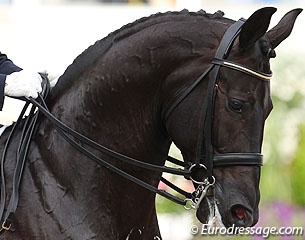
We live in times in which the necessity of the double bridle in high performance and FEI level dressage classes is being questioned much more than it in the past. May it be in magazines or well-known internet forums, dressage enthusiast up to Olympic trainers discuss whether the double bridle is still contemporary. Shouldn't riders be allowed to chose between double bridle and snaffle all the way up to Grand Prix?
Regrettably, the topic is often simplified to the statement that the snaffle is the softer bit and should be preferred. Some even claim that he who can ride a Grand Prix in a snaffle is a better rider. What is less the question is why these discussions arise at all and why the double bridle is often not regarded anymore as what it is supposed to be: an instrument of finest understanding between horse and rider.
Why the Double Bridle?
The double bridle consists of two bits: the bridoon (snaffle bit) and the curb. The centre of all discussion is the latter as it is the most delicate instrument. The way it is fitted and the way it is handled decide if the curb is one of brute force or one that refines riding.
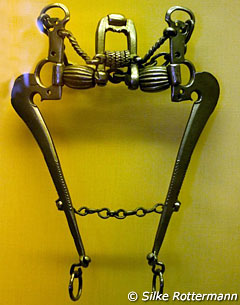 A quick glance at history shows that the curb was invented to serve as an tool of force because it was a bit that enabled knights and cavalrymen to control their horses one-handedly in the most dangerous situations in which control often decided between life or death. It was only during the renaissance time that in France riding masters, most notably Pluvinel and de la Guérnière, discovered and spread the awareness that the curb bit can be used, back then occasionally in combination with a cavesson, as an instrument that enables the rider a higher level of communication with the horse.
A quick glance at history shows that the curb was invented to serve as an tool of force because it was a bit that enabled knights and cavalrymen to control their horses one-handedly in the most dangerous situations in which control often decided between life or death. It was only during the renaissance time that in France riding masters, most notably Pluvinel and de la Guérnière, discovered and spread the awareness that the curb bit can be used, back then occasionally in combination with a cavesson, as an instrument that enables the rider a higher level of communication with the horse.
Since those times the double bridle was considered an essential part in the art of riding, because the correct usage leads not only to a very fine communication, but also increases the horse's collection. To understand how this happens, one must take a closer look at the way the double bridle acts.
The purpose of a Double Bridle
Even though it does not always make sense when we see the indifferent use of the curb -- even in the international dressage rings - these days, both bits of the double bridle fulfill two completely different tasks.
The bridoon (snaffle) acts in a way elevating and bending the horse whereas the curb causes the horse to give the neck and bring the head towards the vertical. In this relation it is the hand of the rider which should sensibly initiate the desired head-neck-position of the horse with the help of the double bridle. However the rider is never allowed to use it as a tool to force the horse into a specific head-neck-position.
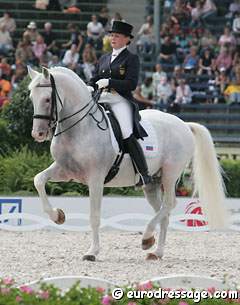 Consequently the correct use of the double bridle is unthinkable and inseparably linked to the concept of the classically and well schooled horse. The activity the hind legs of a well trained horse create flows over the back into the rider's hand. This corresponds with the concept of riding a horse from behind to the front; the only way natural for a horse. This means that a horse is, only then, ready for the double bridle when it has gained a certain degree of collection as it has already obtained a certain degree of self carriage. When we talk of collection we cannot help but point out that this means the horse increases the activity of its hind legs, takes more weight by bending the joints, and comes towards the vertical, as it has risen in the withers and the whole top line.
Consequently the correct use of the double bridle is unthinkable and inseparably linked to the concept of the classically and well schooled horse. The activity the hind legs of a well trained horse create flows over the back into the rider's hand. This corresponds with the concept of riding a horse from behind to the front; the only way natural for a horse. This means that a horse is, only then, ready for the double bridle when it has gained a certain degree of collection as it has already obtained a certain degree of self carriage. When we talk of collection we cannot help but point out that this means the horse increases the activity of its hind legs, takes more weight by bending the joints, and comes towards the vertical, as it has risen in the withers and the whole top line.
While the usage of the double bridle requires collection, it can also increase the amount at the same time. How does this happen? Due to the curb the rider is able to give very refined impulses. The energy of the hind legs flowing to the front gets redirected very promptly back onto the hind legs and as a result the collection and self carriage improve.
Taking this into account, the requirement and use of the double bridle in higher level dressage seems to make great sense. However, the sense of the curb is questioned more and more as a direct consequence of the totally wrong use of the double seen all around, even in the Olympic arena. The outside world gets a negative image of dressage because of re-appearing pictures of renowned horses with gaping mouths and blue tongues as a firmly pulled curb is pressing on the tongue. This images often appear in relation with certain training methods.
How the Double Bridle Acts
To understand why it is so overly important to fit the double bridle correctly, one needs to take a closer look at how it acts in the horse's mouth. Generally the curb influences different parts of the horse's head. As soon as the curb rein is taken, the levers (branches) pull the cheek-pieces of the bridle forwards and as a result the neck-piece puts some pressure on the horse's neck.
The strength of the curb on the neck and mouth is dependent on four factors: Firstly, the length of the upper part of the lever has its effects on the neck because the pressure is transferred through the forwards-movement of the eye to which the cheek-pieces are attached. Secondly the length of the upper and lower part of the levers have their effect on the mouth. Thirdly, the way the curb chain is closed and fourthly the shape of the mouth-piece itself have their effects on the strength of the curb.
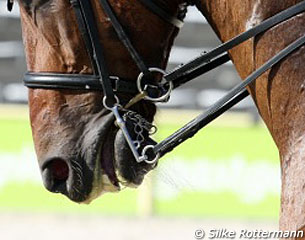 The curb puts pressure on the tongue, the bars, the chin groove and the neck of the horse. If it is correctly applied, the even pressure in the mouth prompts the horse to yield with the lower jaw by relaxing the jaw and bending the neck. Consequently it will bring the head towards the vertical. This movement lifts the base of the neck and the withers, when supported by sufficient activity from the hind-legs carrying weight.
The curb puts pressure on the tongue, the bars, the chin groove and the neck of the horse. If it is correctly applied, the even pressure in the mouth prompts the horse to yield with the lower jaw by relaxing the jaw and bending the neck. Consequently it will bring the head towards the vertical. This movement lifts the base of the neck and the withers, when supported by sufficient activity from the hind-legs carrying weight.
The behaviour and effect of the double bridle are further decided by how the chin chain is attached because all the action on the mouth and neck is caused by it. The recommendation is that the curb chain should be fixed in a way that an angle of approximately 45 ° between levers and bars occur.
There are two extremes or curb use: a bristled-up (strotzend) curb and the unfortunately curerntly more "popular" use of the horizontal curb. Both cases are not correct curb use and trainers, riders and judges should refrain from conding it!
The bristled-up curb has an angle of significantly less than 45 ° and causes the horse to easily resist due to increased pressure, in particular in the neck. The horizontal curb has an angle nearing the 90 ° and simply does not act as a curb anymore. In the worst case the port presses into the palate, resulting in a horse with a gaping mouth, if the mouth is not cranked by a too tight noseband.
There is a Key to Every Horse's Mouth
Finding the most suitable curb bit for each horse depends totally on the indispensable precondition to use it correctly and get the desired effects. Its importance was recognized centuries ago when de la Guérinière wrote in his book 'Ecole de Cavalerie': „The mouth-piece has to be chosen based on the inner construction of the horse's mouth, the levers in relation to his neck and the curb chain based on the sensitivity of his chin.“
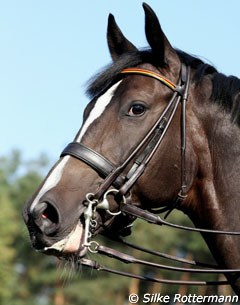 Riders at the beginning of competitive FEI level dressage sport (since 1929) only had a small choice of a few curb models, but back then the loriner profession was still well-known and horses often got tailor-made bits for their needs. Nowadays the market does not offer such anymore, but a huge variety in sizes, width and thickness, as well as many different models and materials are made. Nowadays there should be a curb for every horse's needs and probably this is true, as long as the rider and trainer are knowledgable enough to assess which kind of curb the horse needs! German legendary trainer Richard Wätjen, who emigrated to the USA after World War II, made it clear in his book “Dressurreiten” that there is no art of riding without an extensive knowledge of bridles and bits. He stated that "their precise knowledge is a necessity for every rider."
Riders at the beginning of competitive FEI level dressage sport (since 1929) only had a small choice of a few curb models, but back then the loriner profession was still well-known and horses often got tailor-made bits for their needs. Nowadays the market does not offer such anymore, but a huge variety in sizes, width and thickness, as well as many different models and materials are made. Nowadays there should be a curb for every horse's needs and probably this is true, as long as the rider and trainer are knowledgable enough to assess which kind of curb the horse needs! German legendary trainer Richard Wätjen, who emigrated to the USA after World War II, made it clear in his book “Dressurreiten” that there is no art of riding without an extensive knowledge of bridles and bits. He stated that "their precise knowledge is a necessity for every rider."
The dressage curb is a bit that consists of an unbroken (bar) mouth-piece and levers attached to it. The mouth piece can vary considerably in its thickness and shape as can the levers in their length. Most curbs have a port (tongue groove) which is more or less big and can be different in shape; some have none. While some mouth pieces are straight, others are slightly curved. The levers are usually straight; an exception is the S-shape which the Spanish Riding School uses and which is also allowed according the FEI rules, but hardly ever seen. The length of the levers (going from the mouth piece downwards) allowed by the FEI can differ between 5 cm to 10 cm; usually the mouth-piece is fixed to the levers. Only the curb called "Swivel Weymouth" allows a play of about 1 cm in which the mouth-piece can move up and down. It might be less precise, but it can be very suitable for horses to become relaxed in their mouth.
The impact of a curb in the horse's mouth is determined by all these components, so it is of paramount importance to find one that fits the horse's individual mouth.
The Shape of the Curb Fitted to the Shape of the Mouth
One can say that the less space there is between both jaws, the less space remains for the tongue (of whichever size and length) and as a result the less space there is left for a bit. As a consequence horses with a thin tongue seem more easily bitted than such with a fleshy one, because here one often needs to create space in form of a port. Its height is limited by the shape of the palate whereas the width is limited by the space between the bars. Curbs with a port cause the tongue to (sometimes only partly) to slip in there with the result that the contact of the curb is more directed onto the horse's bars. How big the pressure on them will be is determined by the size of the port: Is it high and wide and gives the tongue space accordingly, then there is more pressure on the bars. With flat and wide ports there seems to be less pressure as the tongue still covers more of the bars and acts stronger as a cushion. The shape of the bars can be another indication which curb is the most suitable. Generally it is said that horses with much thoroughbred blood tend to have narrow bars, so they might prefer a curb with a very small or no port at all so that the tongue is most effected.
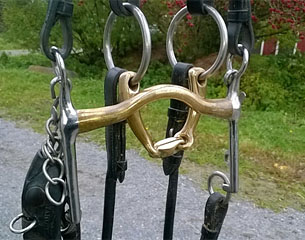 It is logical that the shape and size of tongue and bars cannot be the only indicator when choosing the right curb. The shape of the palate is of similar importance. Is it rather flat, a high port might easily touch the jaw bone and cause visible discomfort. Also there are many horses which simply do not like have their tongues pressed into a port. They prefer a curb without port (French curb), so that the pressure is distributed on the tongue which acts like a cushion if it is not exposed to excessive curb usage. In the end fitting a curb to an individual horse is the result of much consideration, but also to a certain extent of trial and error.
It is logical that the shape and size of tongue and bars cannot be the only indicator when choosing the right curb. The shape of the palate is of similar importance. Is it rather flat, a high port might easily touch the jaw bone and cause visible discomfort. Also there are many horses which simply do not like have their tongues pressed into a port. They prefer a curb without port (French curb), so that the pressure is distributed on the tongue which acts like a cushion if it is not exposed to excessive curb usage. In the end fitting a curb to an individual horse is the result of much consideration, but also to a certain extent of trial and error.
The width of the curb naturally depends on the conformation of the mouth, but unlike with the bridoon or snaffle bit, the curb should be approximately 5 mm wider at each side than the mouth to avoid the lips from being squeezed by the levers. But is the curb wider than that, it can cause imprecise signals from the rider's hands.
No matter which kind of curb a horse's mouth requires, there is a clear guideline in which way the curb chain, which enables the levers to act, should be fitted: There's pretty much unison in renowned riding manuals that the angle of the lower part of the levers should be about 45 ° to the bars when being used. German classicist Müseler recommends in his legendary manual “Reitlehre” that "between the curb chain and the chin of the horse one should be able to comfortably position two fingers." Any angle significantly deviating from the 45 ° recommendation disables correct double bridle use. A slight deviation from the reference point is naturally possible and depends on each horse.
Double Olympic champion and master trainer Klaus Balkenhol thinks that „the 45 ° is an experience value, but it can vary. However, a horizontal as well as an almost vertical curb are wrong. The horizontal curb (with a too loose curb chain) has no effect, the curb with a too tight curb chain puts pressure on the bars and tongue and should always be rejected. Which curb fits the horse best one can only know after a certain time of familiarization."
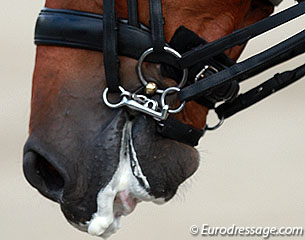 There is no unison in opinion on the length of the levers. While some think the so-called baby curbs with short levers are softer than curbs with long levers, others rightly claim that the action through a baby curb sets in much quicker than the one with long levers. On the other hand riders can be much stronger on a curb with longer levers. The conclusion could be that curbs with short levers are less forgiving to unsteady hands compared to long levers. However, a hard hand might cause less damage with a baby curb. German riding master and Olympic eventing champion Ingrid Klimke, who is known to be a very sensitive rider, prefers "rhe baby curb because I want it as soft as possible," as she very steady hands herself.
There is no unison in opinion on the length of the levers. While some think the so-called baby curbs with short levers are softer than curbs with long levers, others rightly claim that the action through a baby curb sets in much quicker than the one with long levers. On the other hand riders can be much stronger on a curb with longer levers. The conclusion could be that curbs with short levers are less forgiving to unsteady hands compared to long levers. However, a hard hand might cause less damage with a baby curb. German riding master and Olympic eventing champion Ingrid Klimke, who is known to be a very sensitive rider, prefers "rhe baby curb because I want it as soft as possible," as she very steady hands herself.
Whatever individual preferences one might have, de la Guérinière's 300-year old wise words are still valid: "without a good hand of the rider (…) even the best fitting bridle will remain without effect."
How to Hold the Reins
The double bridle is also influenced by the way the rider holds the two pairs of reins. There are at least eight different ways of holding the reins known, even though nowadays we only see very few of them and mostly one method is used in competitions. This was very different before and immediately after World War II. The diversification stopped after the 1960s.
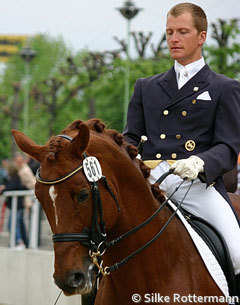
If we make ourselves aware that a rider can influence a horse's way of going with the way he holds the reins, then we must ask ourselves if these so commonly used ways of using the reins of the double-bridle have any big advantages compared to the almost died out ways which will be mentioned later on. The answer is no!
By holding the reins the way in which both reins cross increases the danger of an indifferent use of both bits. One of these dangers is holding the curb rein easily too tight with all the negative consequences: stiff mouth, stiff back, stiff hind legs. Especially an uneven contact can cause the curb to get stuck unilaterally, squeezing tongue and lip on the one side and touching the palate on the other side. The reason why so many riders still hold it this way is that this hold of reins is easier to learn than the more demanding way, which was used extensively many decades ago, often by meticulously schooled members of European cavalry schools or at the Spanish Rising School in Vienna.
Of course a hold of reins where curb and bridoon rein cross is not necessarily bad at all, in particular if the curb rein is simply held about 1 cm longer in order to evade the danger of it becoming too tight. But all too often we see exactly those dangers realized up to the highest levels of competitive riding. Klaus Balkenhol confirms that “today one dedicates too little to riding with the double bridle. One must treat it very delicately. Here the time factor plays an important role. Too early or too quickly are always a disadvantage. One really has to learn to ride with a double bridle.”
The "Exotic" Hold of Reins
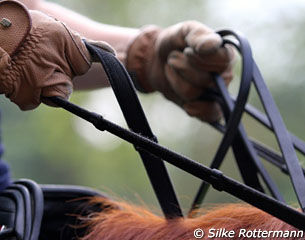 The 3:1- and the Fillis hold-of-reins have still been seen regularly decades ago when the sport was dominated by the military and in the days there still was a very thorough schooling of the riders.
The 3:1- and the Fillis hold-of-reins have still been seen regularly decades ago when the sport was dominated by the military and in the days there still was a very thorough schooling of the riders.
With the 3:1 method which was the traditional way used at the Spanish Riding School in Vienna and which many of Germany's most successful professionals before WW II regularly used, the rider holds the right bridoon rein in the right hand to keep the mouth mobile. Both curb reins plus the left bridoon one are held in the left hand. The clear advantage of this method is an even contact with the curb which is not exposed to the same dangers when holding it in two single hands. But it goes without saying that this method requires not only a totally submissive horse, but also a rider with an immaculate, quiet seat as the bending of the horse must be done mainly by the seat. An uneven contact or a crooked horse is easily revealed with this kind of double bridle handling and cannot be hidden by an uneven use of the curb rein. Also it forces the rider to hold his hands absolutely quiet.
The Fillis hold of reins is named after James Fillis who promoted it successfully, but did not invented it. It is a way of holding the reins that allows a precise separating of bridoon and curb as the first rein usually runs between index finger and thumb and the latter under the pinky. The great variability it offers can be obtained by bending or turning in the wrist. But it goes without saying that this is a very demanding hold of reins which can easily end up with an overly used curb when the rider is not in total control of his hands.
The Fillis method was more popular in the 1950s and 1960s when the first riders from the Soviet Union emerged on the international scene, all schooled after Fillis who had been St. Petersburg's chief rider at the beginning 20th century. Germany's legendary Willi Schultheis used it regularly on some of his horses and it was also occasionally seen with his students, such Canadian dressage legend Cindy Ishoy. Nowadays this hold of reins is, at least in the competition arenas, almost died out, although Kyra Kyrklund used it occasionally.

separating the bridoon and curb precisely
Something totally disappeared from the competition arenas is riding on the curb only, “blank curb”, a hold of reins traditional for the solo display at the Spanish Riding School in Vienna. Even though to some it might sound contradictory, this way using the double bridle prevents a too strong usage of the curb, provided if the rider is on a totally submissive horse. The rider is in need of using his seat most effectively and this requires a highly trained and very sensitive horse reacting to the slightest shifting of weight.
German I-judge Angelika Frömming still trained on the blank crub when she worked with Willi Schultheis at Warendorf a few decades ago: “Riding on the curb only, with a truly submissive and through horse, is child's play. I admit first I thought this would become a catastrophe, but the contrary was the case. The rein aids became incredibly refined and also the seat," Fromming explained.
Is the Double Bridle Outdated?
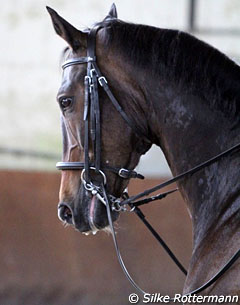 The curb is an instrument of understanding, but this understanding can differ: It can be one of mutual understanding or a unilateral one, making the horse unmistakably clear that it has to obey. The rider makes a conscious choice what way of understanding he aims to achieve when he bits his horse and cranks the noseband: the result shows to onlookers, spectators, and judges alike.
The curb is an instrument of understanding, but this understanding can differ: It can be one of mutual understanding or a unilateral one, making the horse unmistakably clear that it has to obey. The rider makes a conscious choice what way of understanding he aims to achieve when he bits his horse and cranks the noseband: the result shows to onlookers, spectators, and judges alike.
Whether the horse is asked or forced into the contact by the double bridle has serious effects on the whole horse: not only on the contact, but on the quality of its collection and on its inner state of mind. It is natural that while learning to handle a double pair of reins, riders make mistakes which the horse has to deal with. This is negligible. And at all times there are riders less talented in handling the challenges the double bridle. However what is unacceptable and has led to the curb coming into discredit more recently are riders who use the strength of this bit to force the horse into a contact, to put him in unnatural head-neck-position, creating a totally wrong kind of collection. Any serious dressage rider or trainer will reject such bit usage. Klaus Balkenhol: “Never ever should the double bridle be used to force the horse onto the bit, even though riding with a curb originates from war times to control the horses effectively.”
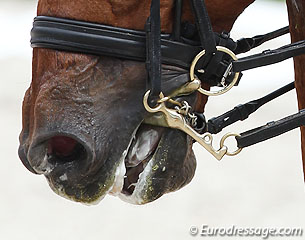 It is not the double bridle that should be discredited, nor the curb bit, but its wrong usage. No matter what the rider's reasons are, judges should not condone bad contact, blue tongues, poor curb use and cranked nosebands! A wrongly used double bridle always has its effects on individual movements in a text, which are marked are marked besides submission. If movements are not marked accordingly, riders are indirectly rewarded for their wrong curb usage and encouraged to obtain “collection” the same way.
It is not the double bridle that should be discredited, nor the curb bit, but its wrong usage. No matter what the rider's reasons are, judges should not condone bad contact, blue tongues, poor curb use and cranked nosebands! A wrongly used double bridle always has its effects on individual movements in a text, which are marked are marked besides submission. If movements are not marked accordingly, riders are indirectly rewarded for their wrong curb usage and encouraged to obtain “collection” the same way.
The Horizontal Curb
It is one thing to use a correctly fitted curb wrongly, but it is another to fit a curb wrongly, which can never result in good use!
There are curbs fitted in a way that they don't act as curbs anymore, but are more or less almost horizontal. By positioning the curb in that way, the curb works rather like a bar snaffle bit. This kind of fitting could be seen at all times, but today it is seen more often than in the past, especially at international Grand Prix competitions! The curb reins are often used with the same tension as the bridoon reins.
Belgian born riding master Jan Bemelmans, who trains the French national team and before had been the Spanish medal “maker” for more than fifteen years, believes "dressage riding has something to do with tradition. To fit the curb chain that we have a 40-45 ° angle is a good thing. To fit the chain in a way that the curb becomes horizontal is not corresponding with the tradition. Of course the horses nowadays are much more refined than some decades ago. They are very light in the neck and some may be afraid that they come more easily behind the vertical with a traditionally fitted curb. But this is also simply a question of how one uses the double bridle. I would welcome it very much if the rideability and the contentment of each horse would also be included in the judging."
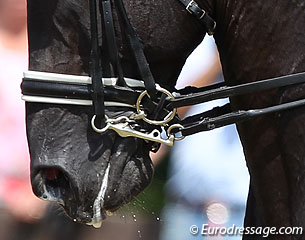 One of his predecessors in France, Christian Carde, is outspoken on the topic of horizontal curbs: "Of course one can play a bit with that 45 ° angle recommendation, but the only reason for me to put the curb near a 90 ° position is that it allows more pulling. It has nothing to do with double bridle riding. And more pulling is the result of a wrong way of training which does not correspond with the classical principles.”
One of his predecessors in France, Christian Carde, is outspoken on the topic of horizontal curbs: "Of course one can play a bit with that 45 ° angle recommendation, but the only reason for me to put the curb near a 90 ° position is that it allows more pulling. It has nothing to do with double bridle riding. And more pulling is the result of a wrong way of training which does not correspond with the classical principles.”
While it seems indisputable that only a correct fitting allows a correct use of the double bridle that leads to a higher degree of collection and a higher degree of understanding, the question remains which possibilities judges have to reprimand any incorrect use! Actually a look into the FEI rule book for dressage gives a clear answer. Article 416 paragraph 2 states that:
“The degree of the submission is also demonstrated by the way the horse accepts the bit, with light and soft contact and a supple poll. The main contact with the horse’s mouth must be through the snaffle bit.” Is this not the case, judges should reduce the collective mark of submission accordingly. The same article (paragraph 2.1) demands that contact problems such as any tongue problems or grinding teeth “must be taken into account by the Judges in their marks for every single movement concerned, as well as in the collective mark for 'submission'.”
Horizontal curbs are mostly used with curb rein tension identical to the bridoon rein. One also sees in the show ring a correctly fitting double bridle with poor rein contact that does not go through the snaffle. Even if this wrong double bridle use does not automatically lead to tongue problems nor grinding teeth, in no way does this use fulfil the requirements of a proper contact with the bridle. Subsequently it should be punished in the collective mark of submission. Unfortunately this hardly ever happens in competitive dressage
Judges have ample opportunity to "punish" the indirect consequences of a wrongly applied curb, when they see riders with unappropriately used double bridles on spectacularly moving horses that hollow their backs and don't track up from behind. However because this down-scoring seldom happens, the public opinion of wrong double-bridle use gets clouded.
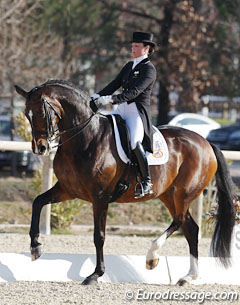 The quality of equitation seems equally endangered when the correct and refined use of the double bridle is not always acknowledged by the judges. Surprisingly and inexplicably, some riders are even punished when they have a loose curb rein and just hold the weight of the curb rein in their hands. It seems to pose a crux to the judges: Is it a constant contact or a missing contact. Certain international riders have been reprimanded for not taking on the curb rein enough!
The quality of equitation seems equally endangered when the correct and refined use of the double bridle is not always acknowledged by the judges. Surprisingly and inexplicably, some riders are even punished when they have a loose curb rein and just hold the weight of the curb rein in their hands. It seems to pose a crux to the judges: Is it a constant contact or a missing contact. Certain international riders have been reprimanded for not taking on the curb rein enough!
The whole discussion of an outdated double bridle and having the option tor ride in a simple snaffle is totally dispensable when correct use were to be rewarded. Nonetheless nothing speaks against giving riders an option. Neither Klaus Balkenhol nor Ingrid Klimke were against letting the riders choose which kind of bridle they want to use. A correctly trained horse will probably perform well in both bridles.
This discussion would also be more quickly nipped in the bud if more riders would simply make the effort to learn to use the double bridle correctly. If more judges were to have the courage to punish a clearly wrong use within the possibilities the FEI rules, the dressage world would take a big step forward.
The double bridle understood as a highly delicate instrument and used with finesse strengthens the mutual communication between rider and horse to a level at which riding actually can become an art. Even in our days sport and art must not inevitably be considered two different games: There were a few rides at the recent WEG in France that have clearly shown that a successful marriage of both is still possible.
by Silke Rottermann for Eurodressage
References
General Decarpentry, Academic Equitation, London 1971, p. 53-62
Elwyn Hartley Edwards (publisher), Sattel, Zaumzeug und Geschirr, Cham 1996, p. 114-145
Francois Robichon de la Guérinère, Reitkunst, Hildesheim 2006, p. 55-71
Wilhelm Müseler, Reitlehre, Berlin and Hamburg 1983, p. 148-150
Gerhard Politz, Use of the Double Bridle, in: Dressage Today 8/2008, p. 47-58
Richard L. Wätjen, Das Dressurreiten, Berlin and Hamburg 1966, p. 24 / 25
Related Links
Noseband Special: Part I: The History of the Noseband
Noseband Special: Part II: The Purpose of the Noseband
Noseband Special: Part III: Riders and Trainers on Their Choice in Noseband
Noseband Special: Part IV: The Thicker, the Wider, the Better?